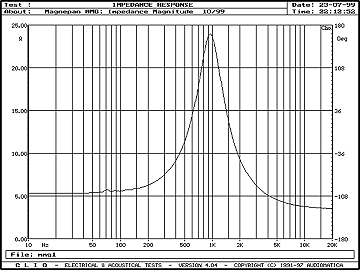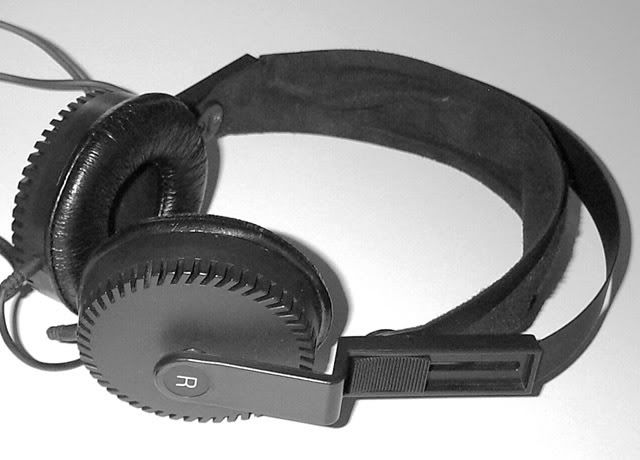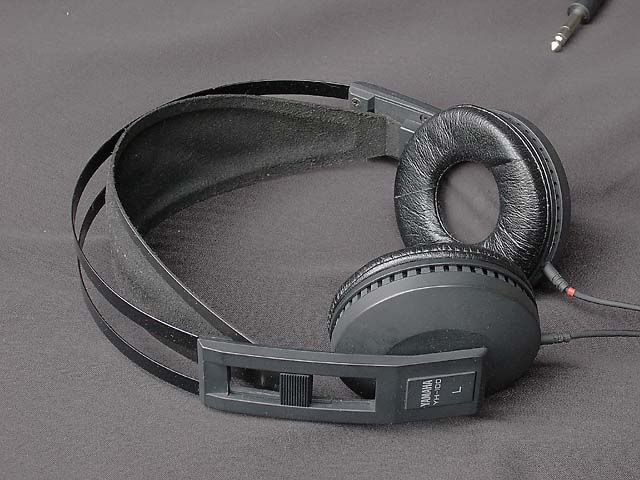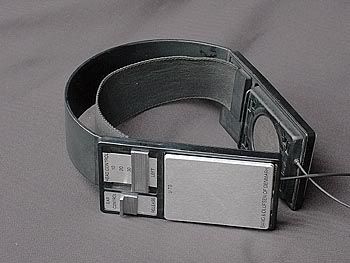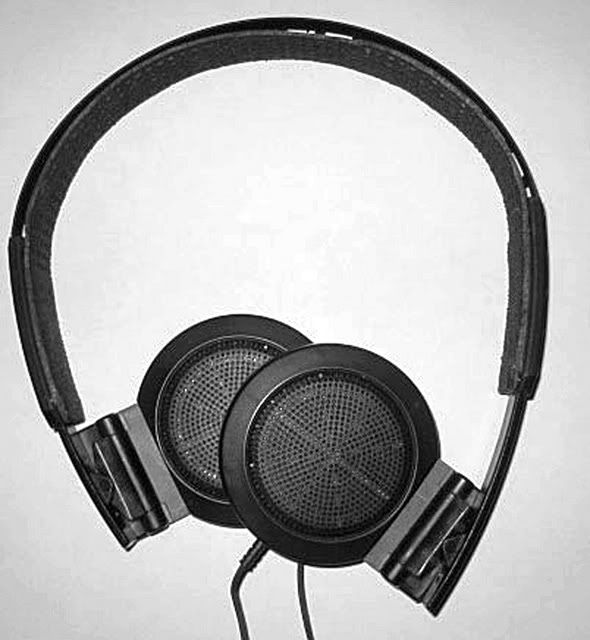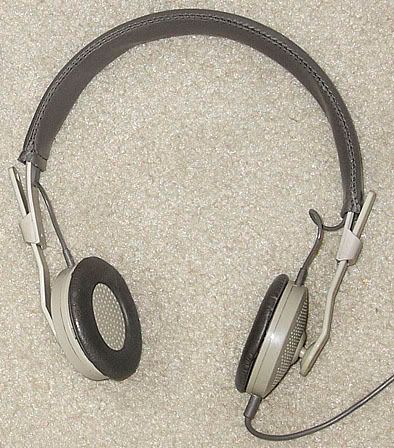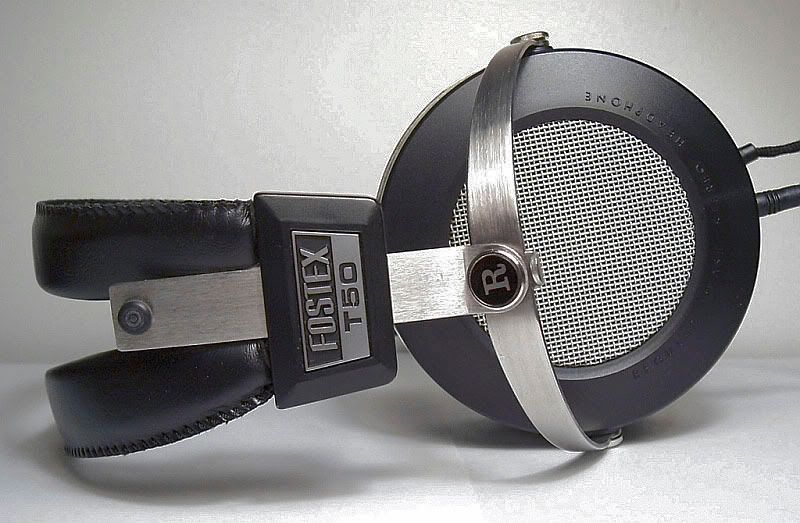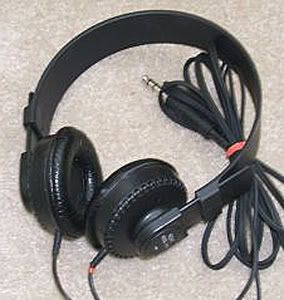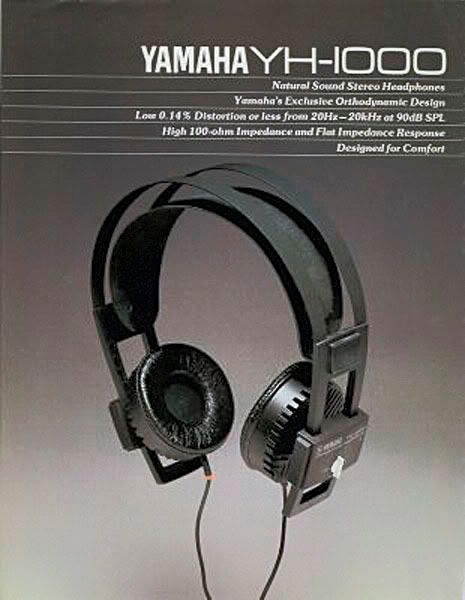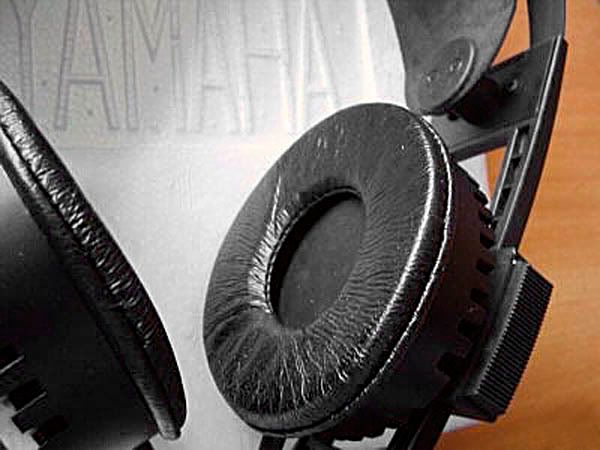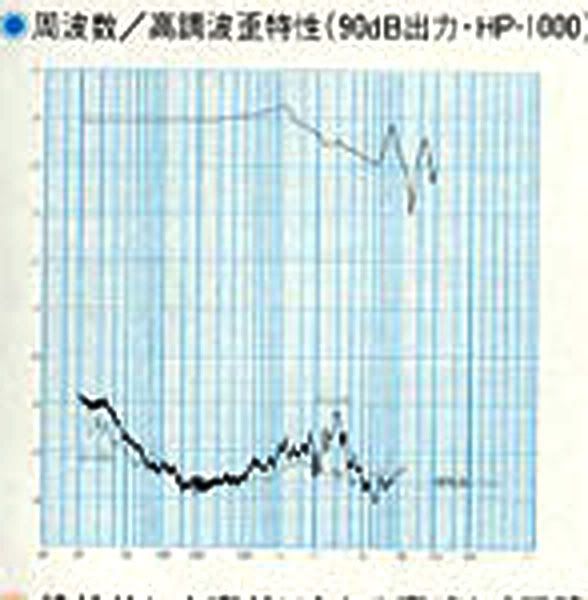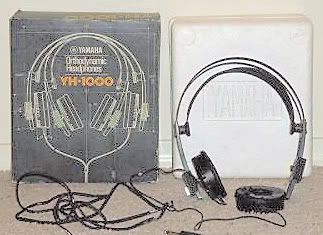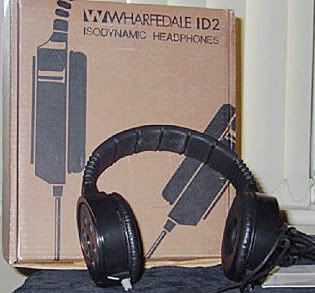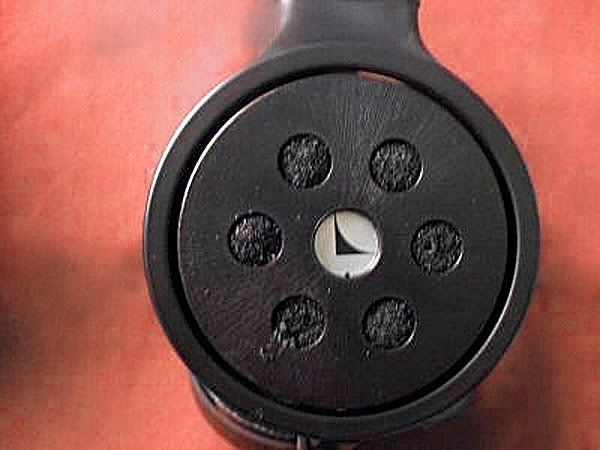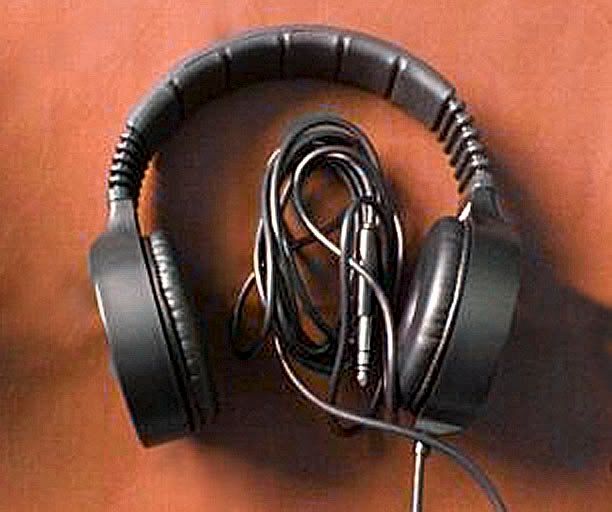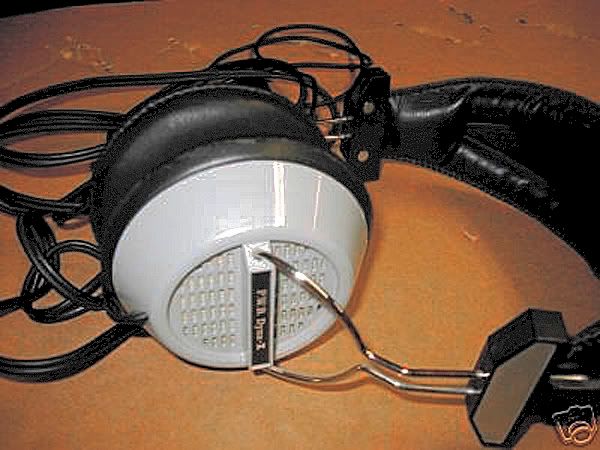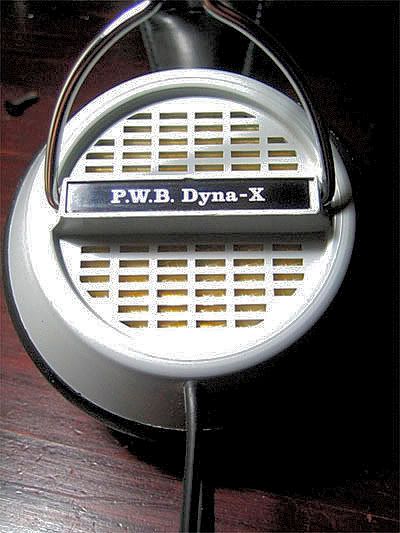Before I start in on the YH-1 and YH-100, it would be good to point out that the isodynamic headphone driver (and this includes all the Orthodynamics) is inherently a dipole-- it radiates sound equally out the back and front, which means that if, when the headphone comes to be designed, the backwave isn't absorbed, deflected, baffled, delayed or otherwise prevented from mixing directly with the frontwave, the bass will completely disappear, since the front and back waves are equally strong and have a kind of matter-antimatter relationship, especially for bass frequencies-- we say that the two are 180 degrees out of phase. They must be kept apart. This is both easier and more complex than it sounds.
Moving-coil drivers can have a strong backwave too, but often this is attenuated, sometimes to zero, by the construction of the individual driver or the cups they're mounted in. Sennheisers have long been a notable exception.
The point is that the backwave must be dealt with. Since letting it leak past the driver's baffle (that is, the surface the driver is mounted to, the one inside the earcup that almost touches your ears) and into the space where your ears are would cause a severe lack of bass, the designer of good open-back 'phones first makes sure the driver is sealed airtight to its baffle, then sends the backwave directly out the back of the cup through something like the "tunnels" on the back of the more expensive Grados, and doesn't put anything in the way that would reflect any of the escaping soundwave back toward the interior of the headphone. This delays the backwave enough so that any bass cancellation that happens due to incomplete earpad sealing is much reduced. The out-of-phase information can even serve to enhance the stereo effect, but consideration of this sends us off to the black art of headphone design, a topic best left for another day.
There's another consideration for Orthodynamic owners, though: If the
treble backwave bounces around the inside of a hard, reflective, closed cup, some of it will bounce right back into and through the diaphragm and into the listener's ears. This is tantamount to putting a wastebasket over the listener's head, since the brain interprets the resultant sound as "big flat surface close to my ears". This isn't hugely oppressive in practice, but the collapsed soundstage of the closed-back Orthodynamics is noticeable when compared to other, more open, headphones. Installation of damping pads alleviates the claustrophobic feeling a bit, but the soundstage is still "closed".
The radical YHD-1 was both open-back
and open-front. That ought to've solved the problem, right? Yes and no. We'll get to that in the next installment.
* * * * * * * * *
YH-1
Since owners of the HP-1 have often spoken of it as THE Orthodynamic, I was surprised to see and hear how similar the YH-1 is, especially in view of the price difference ($200 vs. ~$95). As I said, both were top of the line for their respective model years. In any case, the YH-1 doesn't represent an advance over the HP-1's design in any respect, nor does it seem to be a backward step (in the direction of cheaper construction, &c). What audible difference there is between the two seems to give a little more bass to the YH-1 at the expense of treble extension, once the 'phone has had the damping treatment, but the difference is very minor and could be explained by any number of things.
I'm not certain of the chronology of the YH-1; that is, I don't know when it hit the US/NA market, and I have only basic specs for it. So far, they're identical to the HP-1's:
Impedance: 150 ohms
frequency response: 20-20,000Hz
Rated input: 3w
max input: 10w
Harmonic distortion: < 0.3% at 90dB SPL
Since the YH-100 of 1981 shows both stylistic and electromechanical differences, and the YH-1 and HP-1 are virtually the same, I'm going to assume the YH-1 was an attempt to make a more affordable HP-1 some time between 1976 and 1981.
I can only speculate on the HP-1a, which has only shown up in a single Yamaha brochure [see above] that also shows a square-holed driver. The only mention of it in a magazine was Hans Fantel's test back in September 1975, right around the time the Orthodynamic line was about to be introduced to the US market. It's just possible it was a marketing name for pre-production HP-1s, the ones sent out to reviewers.
* * * * * * * * * * *
YH-100
In any case, the YH-100 shown above is the only top-of-the-line Orthodynamic other than the rare YH-1000 not styled by Mario Bellini. In fact, in this case there is no line in the usual sense. The YH-100 was alone; there is no YH-200 or 300.
It's heavier than the HP-1 and appears to be more substantial except that it has those same @#$! plastic struts. The earcups are bigger, 80mm in diameter versus 72mm. The center opening of the earpads has grown proportionately, making the pads rest partially on and off the ear. Inside, the driver has changed: despite the larger earpieces, it's the same 55mm as the HP-1, but there are thin perforated metal plates covering the front and back of the ferrite "sandwich", presumably to give a boost to the flux gap's field strength and thus to the 'phone's efficiency (about +4dB).
Most importantly, the diaphragm's natural resonant frequency has been lowered, either by increasing the compliance (different pleat shape?) or by thinning the diaphragm material. However it was accomplished, it has the effect of moving the diaphragm's resonant frequency and bass cutoff down an octave or so. Keep in mind that this is speculation based on how the YH-100 sounds compared to its brothers and how it responds to added damping-- taking the magnet sandwich apart for observation or measurements, tempting as the prospect is, would almost certainly destroy it. If someone would like to donate a burnt-out YH-100 (or any other Orthodynamic) so that photos and measurements can be made, PM me.
A more compliant diaphragm should be more capable of "real" bass. Unfortunately, no extra mechanical damping was added to control the expected greater excursion of the diaphragm. The result: a smooth but dull, bass-heavy and hollow sound that was at first very discouraging.
*
Frequency Response: 20 - 20,000Hz (no tolerance given, sigh)
*
Magnet: anisotropic ferrite, 55mm
*
Impedance: 150 ohms
*
Sensitivity: 98dB/mW
*
Rated Input: 3W
*
Maximum Input: 10W
*
Weight (with cord): 390g
Note that the power handling specs are up to HP-1 levels.
Once damping is added, the YH-100s become the most entertaining, if not the flattest, of the Orthodynamic line so far. This is the one whose sound changes most after damping treatment. Especially with a little goosing in the low bass, the sound of the YH-100 could be soberly described as powerful. This, understand, was a great step forward for isodynamic phones, since until the YH-100 their deep bass output had always been referred to, when referred to at all, as polite -- but
this one rocks. Sounds good on classical too.
Some lumpiness in the upper bass remains after my primitive damping treatments, but overall the sound resembles what one would expect from a good modern phone, except of course for the low efficiency and the partially-collapsed soundstage. Yes, I've compared them to the Stax Lambda Nova and the Sennheiser HD 600, and no, I don't hear any transient "crippling". In fact, in some respects (a quality of dry liveliness, snap, alertness, the ability to leap instantly out of silence and then return to silence just as quickly), they are moderately superior.
Unfortunately, the YH-100 appears on eBay less frequently, roughly every 2-3 months. Otherwise, of the Yamaha Orthodynamics I've heard, it's the recommended buy--
if you're willing to intervene and install damping material. Out of the box, the HP-1/YH-1 sounds much better.
Don't buy a YH-100 unless you're willing to take it apart.
Next, the lovably weird (but fatal) YHD series and the end of the line.
* * *
Late addition to the menagerie:
a Bang & Olufsen U70-- Styled by B&O's Jacob Jensen and
made for B&O by what was a merger of Peerless and MB Quart known as PMB, with specs a notch below the HP-1's but with interesting driver differences: the 55mm ferrite discs have
tiny holes, perhaps to add acoustic resistance (ie, damping)..? My sample came without earpads, so there's no bass... yet. Very odd (but of course very stylish) construction-- note that there is again no direct venting of the backwave, giving us the same problems as the Yamaha design: dipole driver firing straight at a blank wall. PMB did add damping in the form of two thick felt pucks that are wedged between the back of the enclosure and the back of the magnet. This, it turns out, is standard damping for PMB-built 'phones, but doesn't guarantee there will be any bass or even that the treble will be flat. See for comparison later in this thread for info on the Telefunken TH 700 and Peerless PMB 100. The B&O's driver looks just like the Telefunken's and the PMB 100's (second version). Also search for other posts by HF member
torrid ear, in real life MB Quart's Willi Presutti, for photos of the 55mm PMB driver used in the PMB 100 and some interesting history and commentary.
U70 Headphones
UPDATE: Adding earpads to the U70 gives a surprising, disappointing result: the pads keep the backwave away and increase effective bass output, but the whole upper octave seems missing! It goes out flat, then seems, subjectively, to drop like a rock. For a panicky moment I though I'd gone partially deaf, as little twiddles on tambourines and other tinkly details were wiped out of certain test songs, but it turns out to be due to some failing of the U70's drivers. So for now the ultrastylish U70 remains a looked-at rather than listened-to headphone, at least for me.
Interestingly, B & O's
next headphone used a conventional dynamic driver and was more or less properly vented. So why couldn't they have done the same for the U70?
More to come...





















